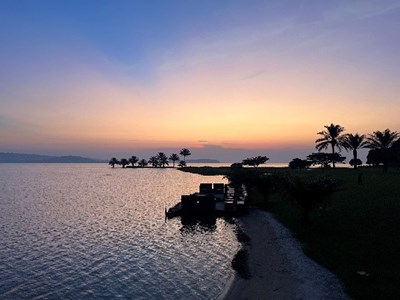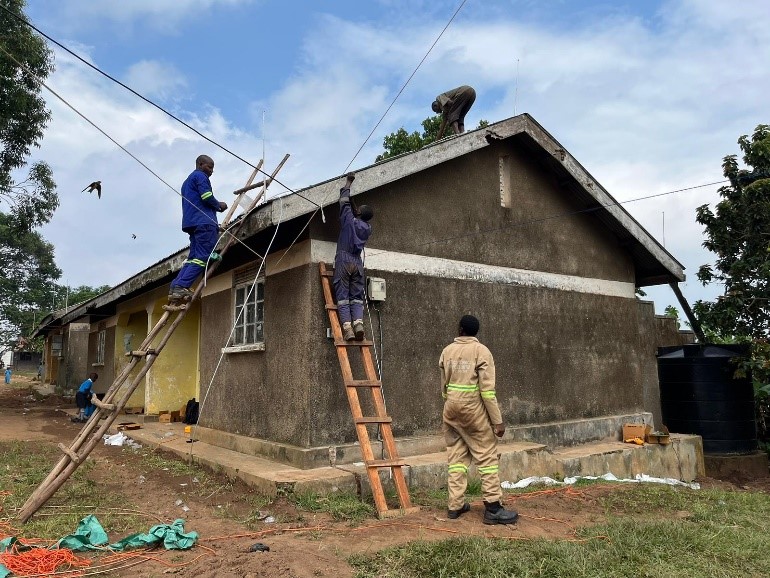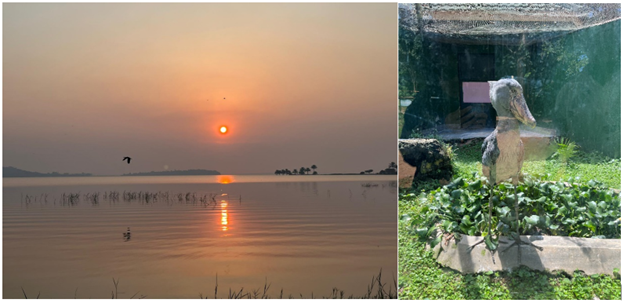CISESS Scientist Daile Zhang works to Mitigate Lightning Hazards in Uganda
August 2, 2024 11:28 AM

Kalangala, Uganda at Sunset
© Daile Zhang
Zhang visited Uganda to Help with the Installation of Lightning Protection Systems at Two Primary Schools in Kalangala
Interviewer: Kate Cooney
Dr. Daile Zhang, an assistant research scientist at the Earth System Science Interdisciplinary Center, has been a CISESS “MVP” since 2019. A meteorologist and lightning physics and detection specialist, Dr. Zhang’s research has focused on evaluating and assessing data from different lightning locating systems, including ground-based and satellite-based networks. Passionate about lightning science education, Dr. Zhang has collaborated with Ronald Holle to develop an informational booklet and publish the Springer book Flashes of Brilliance: The Science and Wonder of Arizona Lightning(2023).
During her five years at CISESS, Dr. Zhang has made far-reaching contributions, not only to scientific advancement, but also to educational outreach, improving public understanding, and promoting lightning safety, and mitigating lightning hazards worldwide. As a member of the National Lightning Safety Council, Dr. Zhang has been dedicated to promoting lightning safety awareness. Dr. Zhang has regularly granted interviews to provide tips on how to stay safe during a stormand dispel myths about lightning. She recently participated in a Reddit Ask-Me-Anything for the 2024 Lightning Safety Awareness Week available in its entirety.
Committed to making a global difference, Dr. Zhang serves on the Board of Directors and manages the official social media platforms of the NGO – African Centres for Lightning and Electromagnetics Network (ACLENet). She recently visited Ugandato help with the installation of lightning protection systems at two primary schools in Kalangala and took the lead on organizing the 2024 International Lightning Safety Day aimed at mitigating lightning hazards worldwide.
Q: What is the significance of International Lightning Safety Day being held every year on June 28th?
A: The ILSD is a commemoration of the young lives lost at Runyanya Primary School when 18 children were killed and at least 38 others were hospitalized from one lightning strike at Runyanya Primary School in Uganda on June 28, 2011.
Q: I understand that this terrible tragedy was the catalyst for the formation of ACLEnet, which has the mission of reducing deaths, injury, and property damage on the African continent. Why are lightning deaths and injuries so prevalent in Africa?
A: Lake Victoria, bordered by Uganda, Tanzania and Kenya, is large enough to generate its own weather patterns which include increased lightning and risk to those who live around these large lakes.
Q: How does the installation of lightning protection systems save lives?
A: An LPS, if installed properly, serves as a faraday cage that diverts the lightning current to the ground. People inside the building, therefore, are safe from lightning strikes.

Q: You recently helped with the installation of a lightning protection system at the St. Victor Mulabana Primary School in Kalangala district, an island on the Lake Victoria. What makes this area particularly vulnerable to lightning hazards?
A: Kalangala is the largest island on Lake Victoria, and a couple thousand people live there. It experiences the most frequent lightning in Uganda because of the lake. Most of the buildings in Kalangala are not lightning safe, and there is even no running water in schools. In addition, Kalangala is a very rural area. The only way to go from Kalangala to the mainland is by ferry (45 min one way, and it runs 4-6 times a day). If someone got injured by lightning, it is very hard for them to get medical help.

Q: In addition to the lightning protection systems, you often advocate that lightning safety education is critical to mitigating lightning hazards. Where is the focus of educational initiatives in Uganda?
A: The lightning myths are always the main problem. People believe what they have been told from childhood and passed on from generation to generation. It is hard to switch their minds. We try to educate the students and young kids at different schools, so that they have the most up-to-date science knowledge about lightning and lightning safety.
Q: What are some of the myths in Uganda that lightning science education can dispel?
A: In East Africa, people believe that wearing red can attract lightning. They also believe that covering the mirror during a thunderstorm can prevent someone being struck by lightning. Some believe that the witches can direct lightning to struck on a specific person or object, so if a lightning struck the tree, the person underneath it is safe. Some schools have their “lightning arrester” which is installed on one of the buildings (and usually not installed properly or needs repair), they think that one single lightning arrester can protect the entire community.
Q: What are some of the challenges to completing the installation project at the second location in Kalangala, Bumangi Primary School, and other regions of Uganda?
A: We have to pay 50% in tax even though the materials are donated by a colleague and friend in the lightning protection community and business. This layer of extra fee is unexpected as we already had a tax exemption form signed by the first lady of Uganda, but for some reason it didn’t work. Now we already shipped the materials and can’t wait for the government to intervene, as we have to pay for storing fees, etc. Because of this unexpected fee, we are facing a financial crisis as we can barely cover the salary and management fees for our team members in Uganda. We have donated materials from our colleagues in the business, but we need donations to cover the salary of our team (a chief engineer and one or two engineer trainees, an in-country coordinator, a finance manager, a communication and education coordinator) and the installation expenses.
Q: What was your overall impression of Uganda?
A: Uganda is very beautiful, and I enjoyed it a lot. The most unique thing is their birds which look like dinosaurs. I thought the shoebill was a wooden sculpture at first, and wondered why they put a fake bird in the glass until it moved its eyebrow.

Q: As you prepare to begin your new position as Assistant Professor at the University of North Dakota, your colleagues have been reflecting on the multitude of ways you contributed to the University of Maryland, ESSIC, and the surrounding community. What will you carry with you from your time here?
A: I thank ESSIC/UMD for the opportunity and experience to prepare me as a good scientist. I will keep my passion and knowledge to continue making contributions to lightning and lightning safety.
« Back